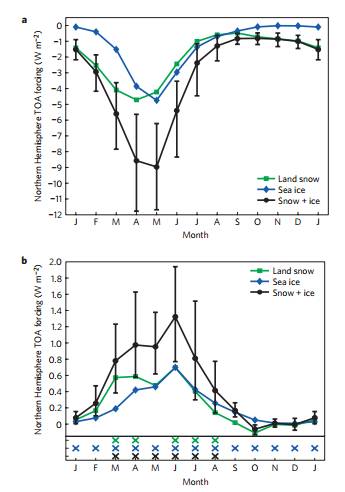
Figure 1 | Seasonal cycles of Northern Hemisphere CrRF and changes in forcing from 1979 to 2008. Contributions to TOA forcing for land-based snowpack (green, squares), sea ice (blue, diamonds) and combined snow+sea-ice (black, circles). a, The mean influence of the cryosphere during 1979–2008. b, 30-year changes calculated from linear trends. The whiskers depict full ranges of snow + sea-ice cryosphere forcing from the 12 all-sky albedo contrast and radiative kernel scenarios listed in Tables 1 and 2. The crosses in b indicate months of statistically significant change at P = 0.01. | The extent of snow cover and sea ice in the Northern Hemisphere has declined since 1979, coincident with hemispheric warming and indicative of a positive feedback of surface reflectivity on climate. This albedo feedback of snow on land has been quantified from observations at seasonal timescales3–6, and century-scale feedback has been assessed using climate models7–10. However, the total impact of the cryosphere on radiative forcing and albedo feedback has yet to be determined from measurements. Here we assess the influence of the Northern Hemisphere cryosphere on Earth's radiation budget at the top of the atmosphere—termed cryosphere radiative forcing—by synthesizing a variety of remote sensing and field measurements. We estimate mean Northern Hemisphere forcing at -4.6 to -2.2 W m-2 , with a peak in May of -9.0 ± 2.7 W m-2 . We find that cyrospheric cooling declined by 0.45 W m-2 from 1979 to 2008, with nearly equal contributions from changes i |